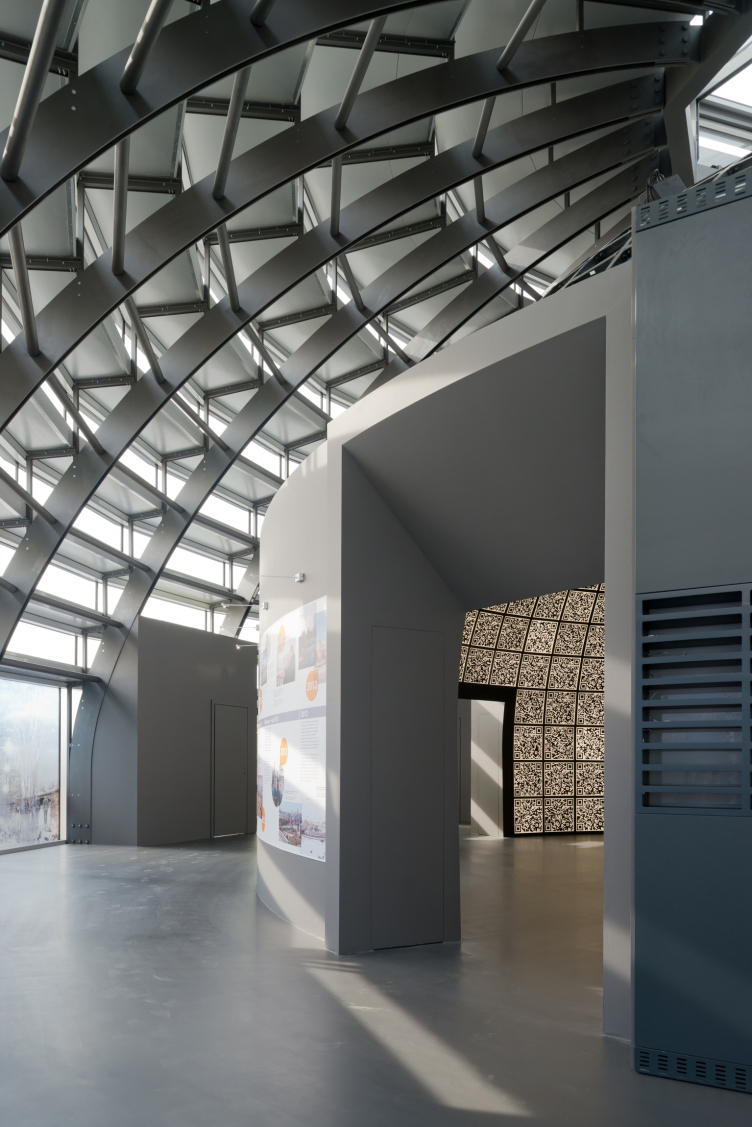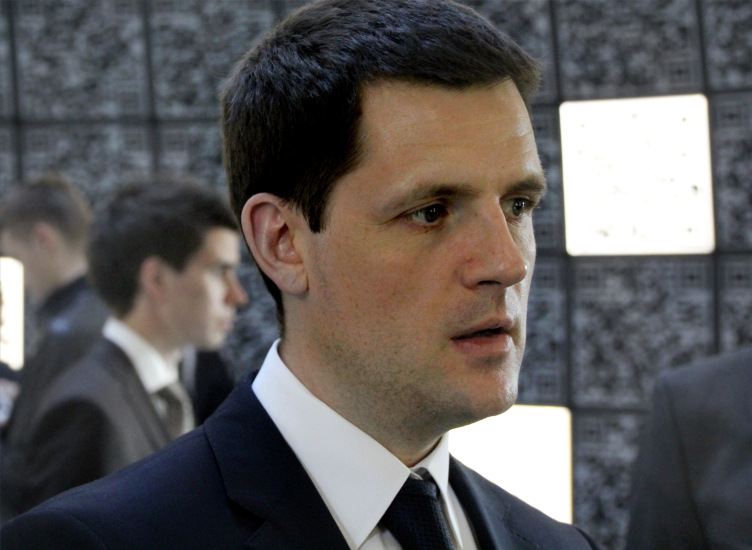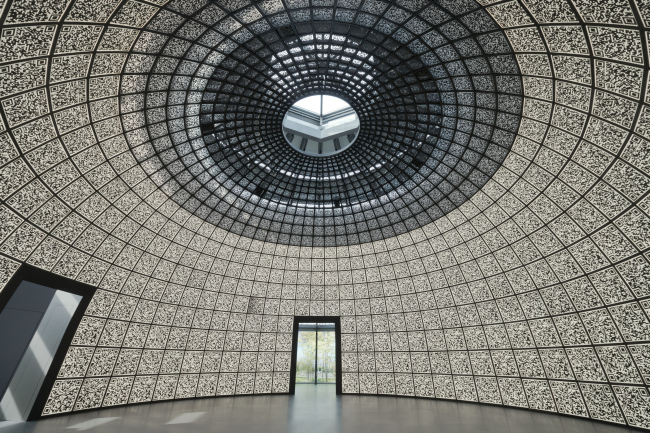
Information pavilion of "Zaryadye" Park. Photo by Ilia Ivanov.
Yesterday, there took place the inauguration of the information pavilion dedicated to the project of "Zaryadye" Park. This solution seems to make a lot of sense: next to the Vassilyevsky Descent, there will appear, if not a fragment of the future park, then at least its representative. And, this new pavilion is not just any info-kiosk: with the effort from SPEECH company, it recreates a copy of the central part of the Russian pavilion at Venice Biennale 2012.
The Venice pavilion of 2012, one that caused a lot of discussion and controversial responses but still noticed by absolutely everybody (incidentally, it got a special mention from the Venice Biennale), was in fact a strikingly-looking hybrid of the classical architectural tradition and modern technology: its central part featured a veritable Pantheon composed of the squares of QR-codes - or, rather, the geometric construct of Pantheon, stripped of all the columns and εἶδος of the roman masterpiece.
And it was this dome core of the Venetian exposition that the architects have now been able to recreate (exactly, on a 1:1 scale) in Zaryadye, filling its QR- codes with a new meaning: back in 2012, in Venice, they showed the projects of Skolkovo science town, while now the fourteen sections are dedicated to the contest projects of Zaryadye park and the history of this area, and the fifteenth tells about the recreated pavilion and its authors. The recreated pavilion became thus a fully-fledged part of the exposition.
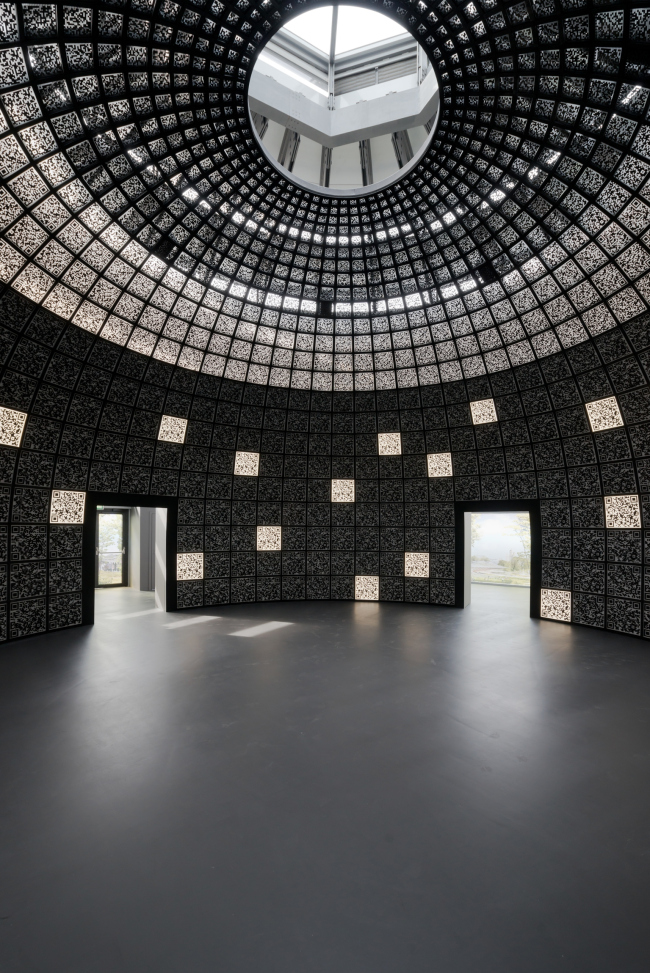
Information pavilion of "Zaryadye" Park. Photo by Ilia Ivanov.

Information pavilion of "Zaryadye" Park. Photo by Ilia Ivanov.
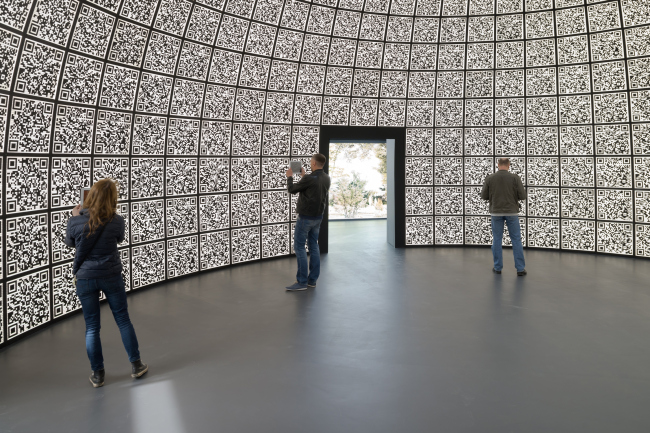
Information pavilion of "Zaryadye" Park. Photo by Ilia Ivanov.
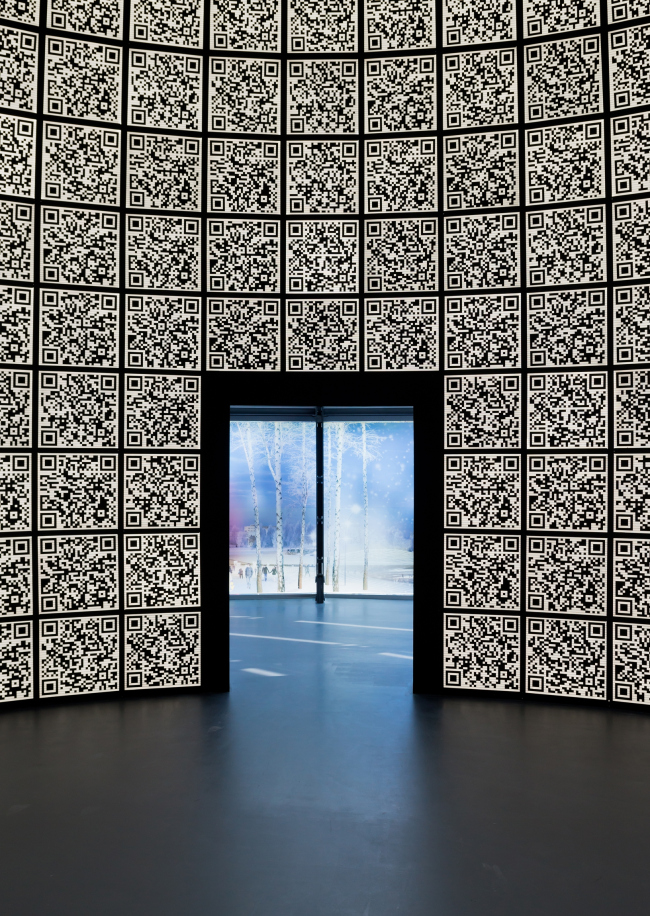
Information pavilion of "Zaryadye" Park. Photo by Ilia Ivanov.
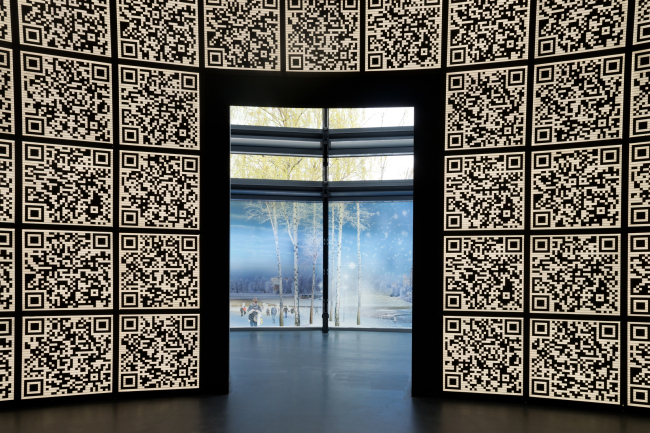
Information pavilion of "Zaryadye" Park. Photo by Ilia Ivanov.
Everything looks as much - from the outside, the digital "Pantheon" looks like a valuable exhibit, it is encased into a glass-and-metal-casing that looks a bit like the Reichstag dome - the modern semi-transparent structure, supported from the inside by the powerful metallic ribs.
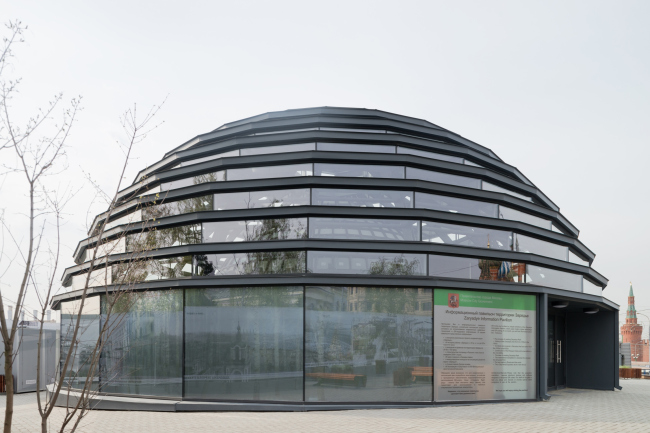
Information pavilion of "Zaryadye" Park. Photo by Ilia Ivanov.

Information pavilion of "Zaryadye" Park. Photo by Ilia Ivanov.
The outside casing considerably "stands back" from the walls of the inner "Venetian" hall - and this results in a spacious circular walkway that in fact serves as a second expo hall (which was not the case in Venice). The inside walls display a short history of Zaryadye, and the outside wall is pasted with semi-transparent film that displays the park, visualized by Diller&Scofidio. Backlit by sunlight, the picture looks almost like the real thing (especially when watched from the very center, through one of the three doors) - and comes into the accurately calculated game with its real surroundings: above the Saint Basil Cathedral, through the glass band, one can see the domes and the turrets of the real cathedral, the painted trees are continued by the branches of the living ones, and in the far perspective some surrealistic twist is added by the fact that half of the painted park is winter, half summer, and it's actually spring outside. If for no other reason, one must visit this pavilion to feel this play if meanings, superimposed on one another like onion peals. On the outside, incidentally, the play of reflections carries on: this is enhanced by the glittering surroundings where the glass facets reflect sometimes the cathedral, sometimes the St. Barbara Church, sometimes the Kremlin Tower, and sometimes just a photograph.
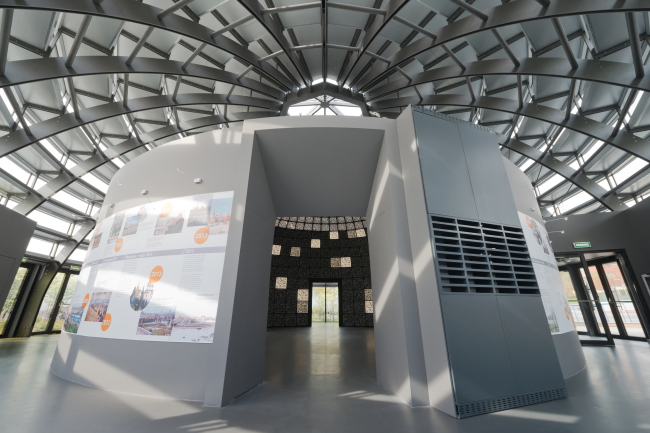
Information pavilion of "Zaryadye" Park. Photo by Ilia Ivanov.
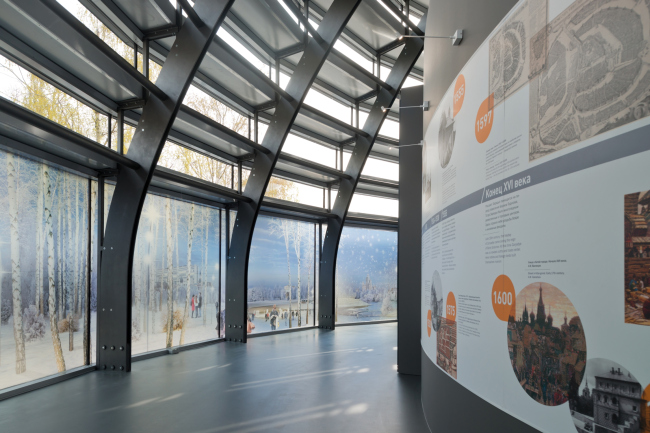
Information pavilion of "Zaryadye" Park. Photo by Ilia Ivanov.
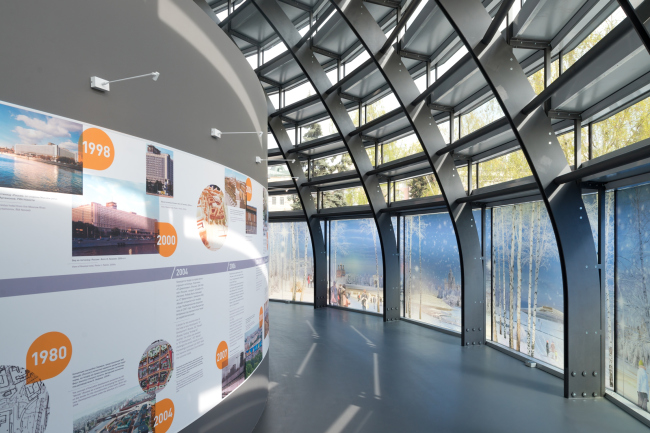
Information pavilion of "Zaryadye" Park. Photo by Ilia Ivanov.
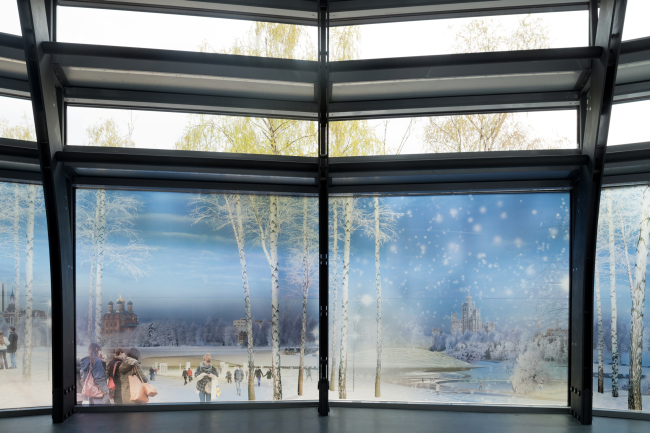
Information pavilion of "Zaryadye" Park. Photo by Ilia Ivanov.
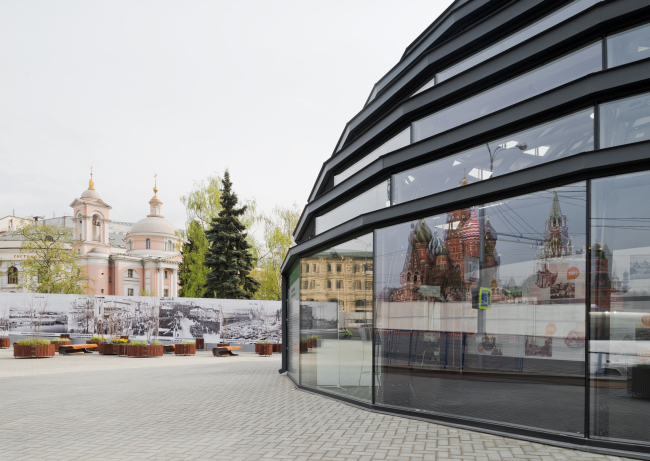
Information pavilion of "Zaryadye" Park. Photo by Ilia Ivanov.
Before the pavilion, there is a small park with flower beds and benches that enhances the impression of a "beginning park".
The pavilion is designed to be a temporary structure but at its inauguration Sergey Kuznetsov expressed his hope that, possibly, his architecture will fit in the future park and will remain there forever. We asked Sergey Kuznetsov, the prime mover of the idea of restoring the Venetian pavilion within the framework of Zaryadye, a few questions.
***
Sergey Kuznetsov,
Chief architect of Moscow:

Sergey Kuznetsov at the inauguration of the pavilion in Zaryadye. Photo by Julia Tarabarina
- How was the idea born of recreating the Venetian pavilion 2012? Why specifically here and now?
- The idea occurred to me in 2013, when I, celebrating my birthday (I generally try to find myself in Venice on my birthdays) was doing a picture of the San-Marco domes. They are really dramatic; it was at that moment that I thought that such a shape would look great in Zaryadye. A dome has a great feature to it: it never conflicts with its surroundings. In relation to the outside space it is pretty universal, and inside it is dramatic... I continued working with this idea and soon came to a conclusion that if I place one dome inside of another, the way Brunelleschi did in Santa-Maria del Fiore, it will be an interesting idea. It took me about a year to implement it. The first pavilion of 2012, as is known, was developed by a fairly large team, and I was only a member of it: I was the co-curator and the co-author of the Venetian pavilion.
Back then, the prime mover behind the whole idea was Sergey Tchoban: Gregory Revzin, Konstantin Chernozatonsky - lots of people participated in this project, to whom I want to say thank you for making thus whole thing possible.
Recreating the pavilion on this particular spot, however, was proposed by me because at this stage I am responsible for the implementation of "Zaryadye" project.
- Isn't there a risk that the classic idea of the dome will conflict the modernist vision of the park proposed by Diller&Scofidio?
- The way I see it, this dome is a totally today's structure. I firmly believe that the best examples of contemporary architecture bear the mark of classicism.
- As the co-author of the first pavilion, do you have any problems with the very fact if repeating, or even cloning your creation?
- We do everything in our power to honor the history of this project and the continuity of the 2012 pavilion. One of the fifteen information sections is in fact dedicated to the Venetian pavilion. I would even say that we use the success of the Russian pavilion at the Biennale to build the new success of "Zaryadye" park. I think this is the right thing to do because history gets stored in layers - just like in Rome.
Basically, I view the recreation of the Venetian pavilion more like carrying it over here from Venice to Moscow. Otherwise it would only have been kept on pictures and in books, not to be seen with one' sown eyes. It can be put on a par with the Montreal pavilion at the All-Russia Exhibition Center or the "Worker and a Woman Farmer" sculpture by Vera Mukhina. Now it was our turn and we recreated the Venetian pavilion 2012.
- As a co-author of the pavilion and the author of the idea of its recreation, what would you think of its further copies? Does today's replica presuppose any further replication or does it not?
- Theoretically, you can put the "Worker and a Woman Farmer" next to the already existing one and then copy-paste them to infinity. Still, nobody would do it, of course, because this would not make any sense. Same thing here. For me, this is a one-time recreation of a specific piece of architecture. And this particular piece of architecture has every right to be considered original because all its authors are good and well, and they took part in its recreation. Should this become necessary, will will be able to use the QR-codes in a different way but the dome itself is a unique work of art, and it cannot be repeated. It's just that for some time it stood in another country and now it will stand here.
***
Information:
The international contest for design project of the architectural concept of "Zaryadye" park was closed in November 2013. The contest was won by the consortium headed by the company Diller Scofidio + Renfro (USA), and including the landscape architects Нargreaves Associates (USA), and Russian urbanists Citymakers (Russia-Denmark).
The information pavilion in which one can find out more about the "Zaryadye" project, as well as see for himself or herself the main part of the Venetian pavilion 2012, is open on the weekdays 11 am - 8 pm, and on the weekend 10 am - 7 pm.
Information pavilion of "Zaryadye" Park. Photo by Ilia Ivanov.
Information pavilion of "Zaryadye" Park. Photo by Ilia Ivanov.
Information pavilion of "Zaryadye" Park. Photo by Ilia Ivanov.
Information pavilion of "Zaryadye" Park. Photo by Ilia Ivanov.
Information pavilion of "Zaryadye" Park. Photo by Ilia Ivanov.
Information pavilion of "Zaryadye" Park. Photo by Ilia Ivanov.
Information pavilion of "Zaryadye" Park. Photo by Ilia Ivanov.
Information pavilion of "Zaryadye" Park. Photo by Ilia Ivanov.
Information pavilion of "Zaryadye" Park. Photo by Ilia Ivanov.
Information pavilion of "Zaryadye" Park. Photo by Ilia Ivanov.
Information pavilion of "Zaryadye" Park. Photo by Ilia Ivanov.
Information pavilion of "Zaryadye" Park. Photo by Ilia Ivanov.
Information pavilion of "Zaryadye" Park. Photo by Ilia Ivanov.
Sergey Kuznetsov at the inauguration of the pavilion in Zaryadye. Photo by Julia Tarabarina










